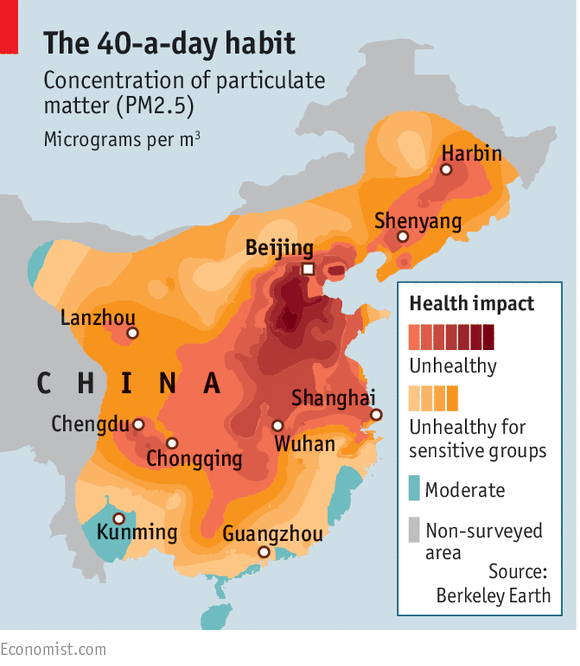The environment
Mapping the invisible scourge
A new study suggests that air pollution is even worse than thought
Aug 15th 2015 | BEIJING | From the print edition
来源:Economist
翻译:Z.K.

THE capital’s “airpocalypse”, the choking smog that descended on Beijing in the winter of 2012-13, galvanised public opinion and spooked the government. The strange thing is, though, that information about air pollution—how extensive it is, how much damage it does—has long been sketchy, based mostly on satellite data or computer models. Until now.
2012到2013年,在首都突然出现的“末日空气”,即一种让人窒息的烟雾,让民众和政府震惊。然而,奇怪的是,直到现在,关于空气污染的信息,它的传播范围,它的危害,长期以来都是不确定的,因为这些信息主要是基于卫星数据和计算机模型。
Responding to the outcry, the government set up a national air-reporting system which now has almost 1,000 monitoring stations, pumping out hourly reports on six pollutants, including sulphur dioxide, ozone and (the main culprit) particulate matter less than 2.5 microns in diameter, or PM2.5. These are tiny particles which lodge in the lungs and cause respiratory disease. The six are the main cause of local pollution but have little to do with climate change, since they do not include carbon dioxide, the main greenhouse gas. Scientists from Berkeley Earth, a not-for-profit foundation in America, have trawled through this recent cloud of data for the four months to early August 2014, sieved out the bits that are manifestly wrong (readings where the dial seems to be stuck, for instance) and emerged with the most detailed and up-to-date picture of Chinese air pollution so far.
为了平息公众的愤怒情绪,政府建立了国家环境空气报告系统,现在已经有将近1,000个监测站,每小时抽取6种污染物进行检测报告,包括二氧化硫,臭氧和空气污染的罪魁祸首,直径小于2.5微米的悬浮颗粒,简称为PM2.5等物质。这些微小的颗粒会随着呼吸滞留在肺部,造成呼吸系统疾病。这六种是造成局部空气污染的主要原因,但是对气候变化影响不大,因为它们没有包括二氧化碳,这是主要的温室气体。来自美国非盈利机构Berkeley Earth的科学家收集了2014年8月份以后四个月的云数据,剔除明显的错误数据(比如某些数据明显是因为仪器表盘被卡住造成的),绘制出了迄今为止最新最详细的中国空气污染图。
Pollution is sky-high everywhere in China. Some 83% of Chinese are exposed to air that, in America, would be deemed by the Environmental Protection Agency either to be unhealthy or unhealthy for sensitive groups. Almost half the population of China experiences levels of PM2.5 that are above America’s highest threshold. That is even worse than the satellite data had suggested.
中国各地的污染是非常高的。中国有83%的人群暴露在大气中,这种环境在美国会被环境保护局认定为不健康的或者是对敏感人群不健康的。中国将近有一般的人生活在PM2.5含量高于美国最高值的环境当中。这比卫星数据所显示的还要严重。
Berkeley Earth’s scientific director, Richard Muller, says breathing Beijing’s air is the equivalent of smoking almost 40 cigarettes a day and calculates that air pollution causes 1.6m deaths a year in China, or 17% of the total. A previous estimate, based on a study of pollution in the Huai river basin (which lies between the Yellow and Yangzi rivers), put the toll at 1.2m deaths a year—still high.
Berkeley Earth的科学主任,Richard Muller说,呼吸北京的空气相当于每天吸40根烟,并且据计算,空气污染造成每年1,600,000人死亡,占整个死亡人口的17%。根据一个关于淮河流域(位于长江和黄河之间)的环境调查。之前的估计是环境污染造成1,200,000人死亡,这个死亡人数仍然相当高。
The sliver of good news is that pollution levels are better in some places than in others. They are worst in the corridor between Beijing and Shanghai and least bad in the south (see map—the study covers China east of 95ºE, accounting for 97% of China’s population), probably because that area was washed by monsoon rains during the period of the study. More importantly, levels of PM2.5 in large western cities such as Chongqing and Chengdu are about half the national average. Figuring out what they are doing right would be a first step towards reducing the smog elsewhere.
好消息是,有一些地方的环境要好一些。在北京和上海之间的廊型地区,环境最差,其次是南方(见地图,这项研究包括了中国东经95°,中国95%的人口生活在这个区域内),也许是因为这个区域在该项调查期间被季风降雨洗涤过。更重要的是,子啊西部的大城市,比如重庆和程度,PM2.5水平只有整个国家平均值的一半。搞清楚他们做了什么是降低其他地方雾霾的第一步。




 京公网安备 11010502036488号
京公网安备 11010502036488号